TS 10th Class English Guide Unit 7C Unity in Diversity in India
Question 1.
What do you understand by the expression Unity in diversity?
Answer:
India is a country of many ethnic groups myriad languages, a veritable babel of tongues and numerous modes of apparel. Though there are several religions, sects and beliefs, there are certain common links and uniting bonds that people have sought to develop in order to achieve the desirable goal of Unity in Diversity. People of different races, cultures, religions and regions live together in our country with the feeling of oneness
Question 2.
Which aspect is Smith commenting on?
Answer:
Smith is commenting on the distinguished features of India that makes it significant and extraordinary. But the feeling of unity is quite common for every Indian in terms of human, social and intellectual development
Question 3.
Pick out the factors that contribute to Unity in Diversity?
Answer:
- A certain underlying uniformity of life
- Historically existing political consciousness
- The cultural heritage we have
- Willingness to accept the good
- Importance given for spiritual wisdom
- Ideals like love, universal brotherhood, fear of God, piety and unselfishness, control of passions and peace of mind
Question 4.
Why did the writer use the statement, "It is a mere collection of separate people" ?
Answer:
The statement "It is a mere collection of separate people" means that the geographical region has a lot many group of people who follow different languages, religious beliefs, cultural practices, food habits etc
Question 5.
"Hindi is now understood and recognised as the national language of India. Do you agree with the statement or disagree with the author? Give reasons?
Answer:
Yes, Hindi is considered as the lingua franca of India. From north to south of India, from east to west, Hindi is understood and recognised as the national language of India. Hindi, like English, is understood in almost every part of the country and stands as a symbol of unity and brotherhood in the present civilization
Vocabulary
I. Read the following words/phrases and find the words/ phrases from the text which convey the same meaning
Question 1.
myriad __________?
Answer:
myraid : many, composite, several, numerous
Question 2.
synthesis __________?
Answer:
synthesi : uniting bonds, aggregate, whole, uniformity, assimilate
Question 3.
diversity __________?
Answer:
diversity : composite, disunity, varied, separate, contrast
Question 4.
dialects __________?
Answer:
dialects : language, tribal language
Question 5.
saints __________?
Answer:
saints : yogis, maharishis, spiritual leaders
II. Read the phrases and find the suitable words equivalent to them from the text
Questiona).
a part of country __________?
Answer:
a part of country : land
Questionb).
try to do __________?
Answer:
try to do : seek to develop
Questionc).
develop quickly __________?
Answer:
develop quickly : flourish
Questiond).
behave in a particular way __________?
Answer:
behave in a particular way : emulate
Questione).
a very sad event __________?
Answer:
a very sad event : tragedy
I. Fill in the table with the most appropriate dance form related to each state and the occasion on which it is performed
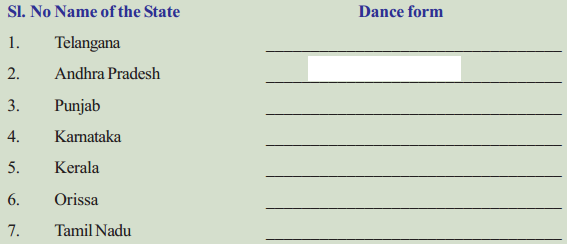
Answer:
| Name of the State |
Dance form |
| 1. Telangana |
Perini Dance |
| 2. Andhra Pradesh |
Kuchipudi, Kolattam |
| 3. Punjab |
Bhangra, Giddha |
| 4. Karnataka |
Yakshagana, Bayalata |
| 5. Kerala |
Kathakali, Mohiniyattam |
| 6. Oriss |
Odissi, Ghumana |
| 7. Tamil Nadu |
Bharatanatyam, Kummi |
Question.
Develop a write upon any one of the dance forms of India.
Remember to focus on the following points?
- The area it belongs to
- When is it performed
- Description of the dance
Answer:
A write up on Bharatnatyam :
Bharatnatyam is one of the most popular classical Indian dances. Bharatnatyam Dance - Bha-Bhavam (means expression), Ra-Ragam (means music), Ta - Talam (means beat or rhythm) and Natyam (means dance) inTamil. Bharatnatyam is more popular in South Indian States of Tamil Nadu and Karnataka. Today, it is recognized as the national dance of India. Bharatnatyam is named after Bharat Muni, author of the bible of classical Indian dance called Natya Shastra. This dance form is a communion of expression, melody and rhythm
Bharatnatyam is accompanied by the classical Carnatic music. It has emerged as an offering to gods in temples in South India. The dance is famous for its delicacy and perfection of movements which makes it vibrant and influential. In the ancient times, Bharatnatyam was performed by Devadasis in the temples of Tamil Nadu known as dasiattam
Tanjore Quartet, Chinniah, Sivanandam, Ponniah and Vadivelu codified its Mudras on earth. The various forms of the dance, like Alarippu, Jathiswaram, Sabdham, Varnam and Tilana were also introduced by them. The philosophy behind this dance form is to search the human soul and unite with the Supreme Being. This dance form enhances its beauty with the use of literary masterpieces of saints and sages
Comtemporary classical Indian dance is performed by both males and females. Bharatnatyam dance forms are also used to present various themes such as unity of religions, nationalism, purity of environment, greatness of a king etc. While the dance itself is absolutely appealing and enigmatic, what makes it all the more compelling is the traditional dress and a touch of make up
There are three main elements of Bharatnatyam namely Nritta, Natya and Mritya. Music for Bharatnatyam is based on Carnatic classical music. Veena, flute, mridangam and violin are the instruments used for music, some of the popular Bharatnatyam performers are Shobhana, Padmini, Bala Saraswathi, Mrinalini Sarabhai, Kamala Laxman, Padma Subrahmaniam and Chithra Visweswaran
Project Work
Question.
Collect the data from different families in your area about the festivals they celebrate. You may use the following table to collect the information?
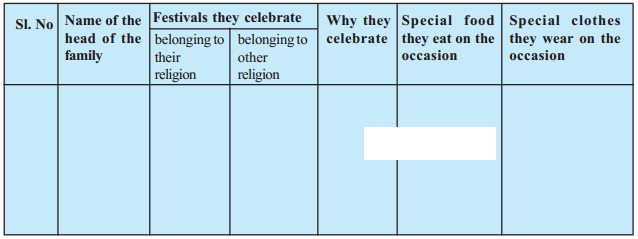
Answer:
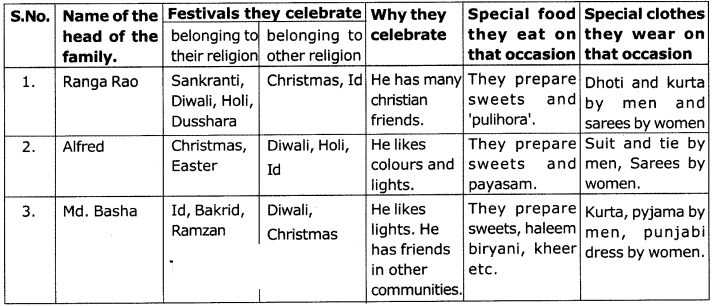
QuestionII.
Discuss in groups how the data in the Table given above supports the concept of unity In diversity. You may also discuss if there are some other ways that too may help strengthen this unity?
Answer:
The above table totally supports the concept of Unity in Diversity. Though the families mentioned in the table are related to different religions, they celebrate all the festivals with much interest. Though Ranga Raos family is a Hindu family, the members of that family celebrate the festivals Christmas and Id. Though Alfred is a Christian, his family celebrates Diwali, Holi and Id as well
The next family is of Md. Basha, a Muslim. Still his family celebrates the festivals such as Diwali and Christmas. All these incidents show us the religious harmony among the Indians. Following the different traditions and cultures which diverse societies in India have developed, there lies a sense of unity which keeps the people of India bonded together. This fundamental unity can be observed among all the Indians and races. People of different religions, castes, regions live together and have deep respect for each other in our country
India is probably the only country in the world where people belonging to different religions, castes and creeds, speaking different languages, having different cultures, different modes of living, different clothing, worshipping different gods live together in harmony with the feeling of oneness. This is nothing but Unity in Diversity
Some ways that help strengthen the Unity:
- Love your fellow as yourself.
- You must know that every human being is worthy of profound respect.
- Look for ways to help others.
- You must focus on the positive.
- Share your wisdom.
- No discrimination should exist.
- Develop the feeling of oneness.
Self Assessment
Question.
How well have I understood this unit?
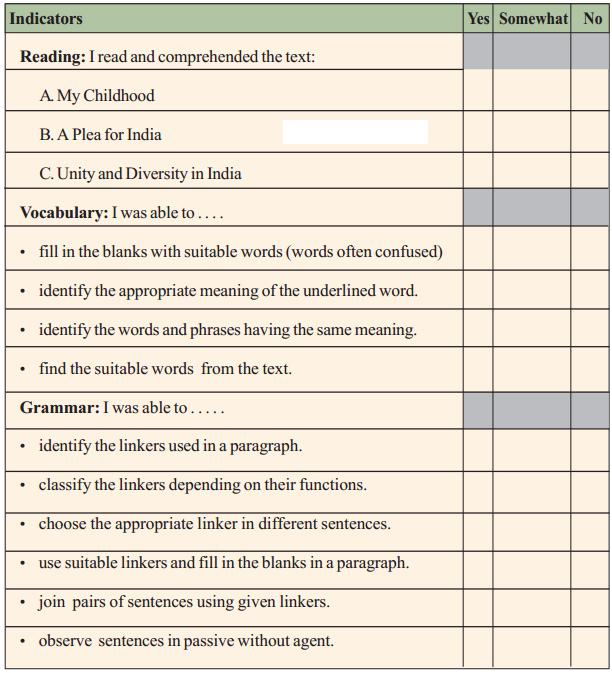
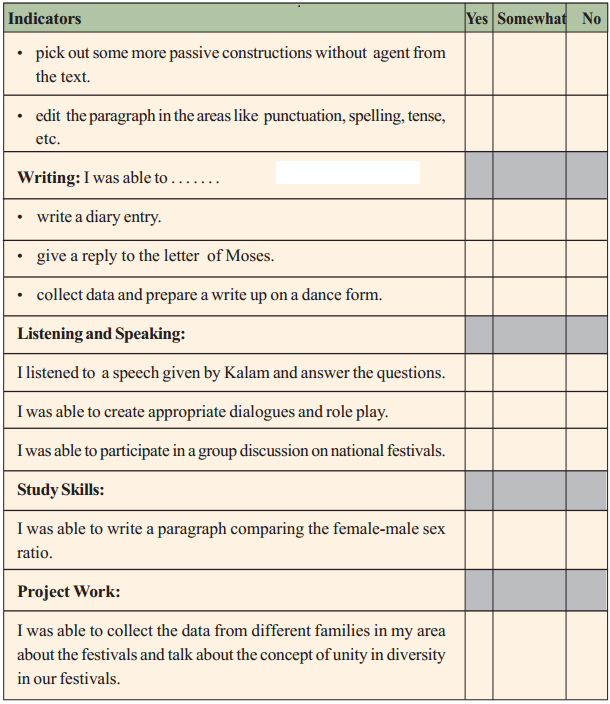
Answer:
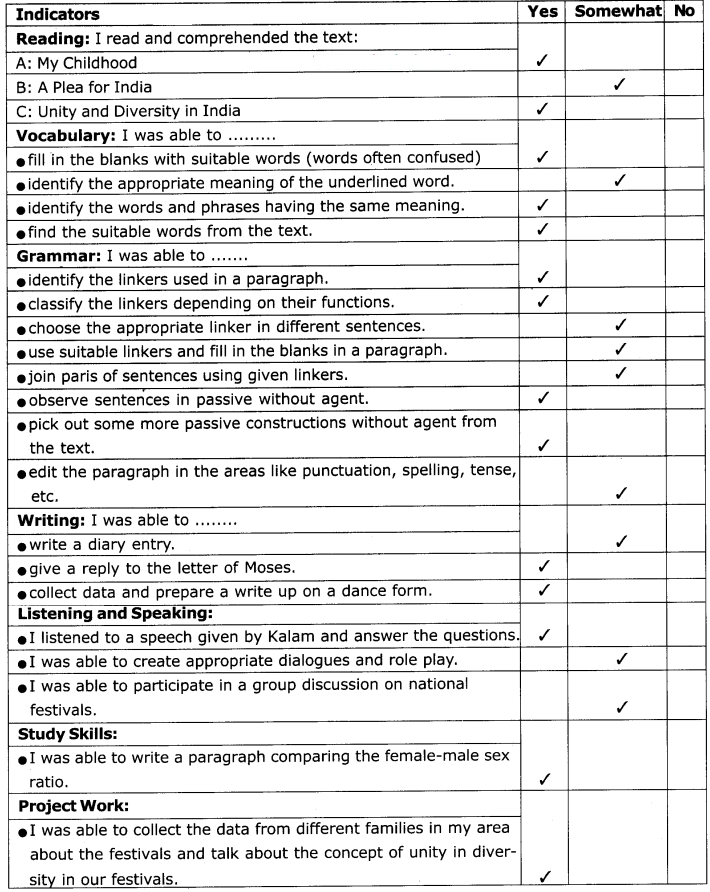
Unity in Diversity in India Summary in English
India is a nation which has a lot of divesities, in several aspects like ethnic groups, caste, region, religion, language etc. Still, all are connected with some unique bonds. This is a much surprising fact, for the observers. Only through a thorough and deep interpretation, one can understand or get a clear view of it all, as a whole. This is because of the fact that these manifold diversions provide India with a source of strength and wealth
History says that the element of unity among all these differences is not new. There has been a political consciousness that whole India is a unit, even for centuries. This was all as a result of inflows of varied cultures. Dravidians were in India even before the Aryans. Hinduism has gladly accepted and blended these cultural differences and variations, throughout the nation. Still, there are diverse aspects in our culture
Language is another area with one hundred and fifty dialects and twenty two officially accepted languages. But, as English is for the world, Hindi is for India. The cultural diversities with music, fine arts, dance, drama, theatre and sculptures form a valuable treasure. The scriptures, temples etc. are treasure houses of spiritual wisdom. The Western world has been eagerly looking forward to India, to acquire this wisdom
Classical music of India which is built on the concept of ragas and talas is another area with about 250 Ragas, which are common in both North and South of India, has some ragas specific for some peculiar time as well. Experts like Pandit Ravi Sankar here popularised the classical music to the West. Indian dances have not only a lot of variety, but colourful and emotional richness
Where as the success of West is basically on materialistic achievements and superficial prosperity, India has given importance to the concept of humanism, integrity and spiritual virtue
Glossory
ethnic (adj) = connected with/belonging to a nation, race or people that shares a cultural tradition.
myraid (adj) = an extremely large number of
babel (n) = the sound of many voices talking at a time
amidst (prep) = in the middle of
superficial (adj) = external or outward
astonish (v) = to cause surprise
aggregate (n) = something formed by adding together many things
interpretation (n) = an explanation / opinion
penetrate (v) = go into / through
manifold (adj) = many and several different types
discern (v) = to know/recognize or understand
civilisation (n) = human society with well developed social organisation
assimilate (v) = to become a part of something
convention (n) = the way in which most people do
heir (n) = some one who has the right to have the authority in succession
heritage (n) = features belonging to the culture of a particular society
blend (v) = to mixe two or more substances together
dialcts (n) = the form of a language that in spoken in one area
inheritor (n) = A person who has been given something by someone when he is on authority
sages (n) = wise people
spiritual (adj) = relating to deep religious feeling
charity (n) = a system of donating things to the poor or needy
contemplation (n) = the act of thinking deeply about
seers (n) = = people who claim that they can see what is going to happen in the future
piety (n) = showing a deep respect for (eg:-for god/religion)
penance (n) = Voluntray self punishment for wrong doings
aesthetic (adj) = Relating to enjoyment
emulate (v) = To try to do something as well as somebody else
because you admire these
veritable (adj) = real, true
babel (n) = the sound of many voices talking at a time
apparel (n) = mode of dress
diversities (n) = differences
eminent (adj) = important
bewildered (v) = confused
synthesis (n) = combination
cape comorin (n) = Kanya Kumari
flourished (v) = existed in abundance
creed (n) = a system of religious belief
lingua franca (n) = a medium of communication between people of different languages.
bridged (v) = connected
virtuosity (n) = talent
accompaniment = supplement
dazed (v) = astonished
quest (n) = desire
isolated (adj) = lonely